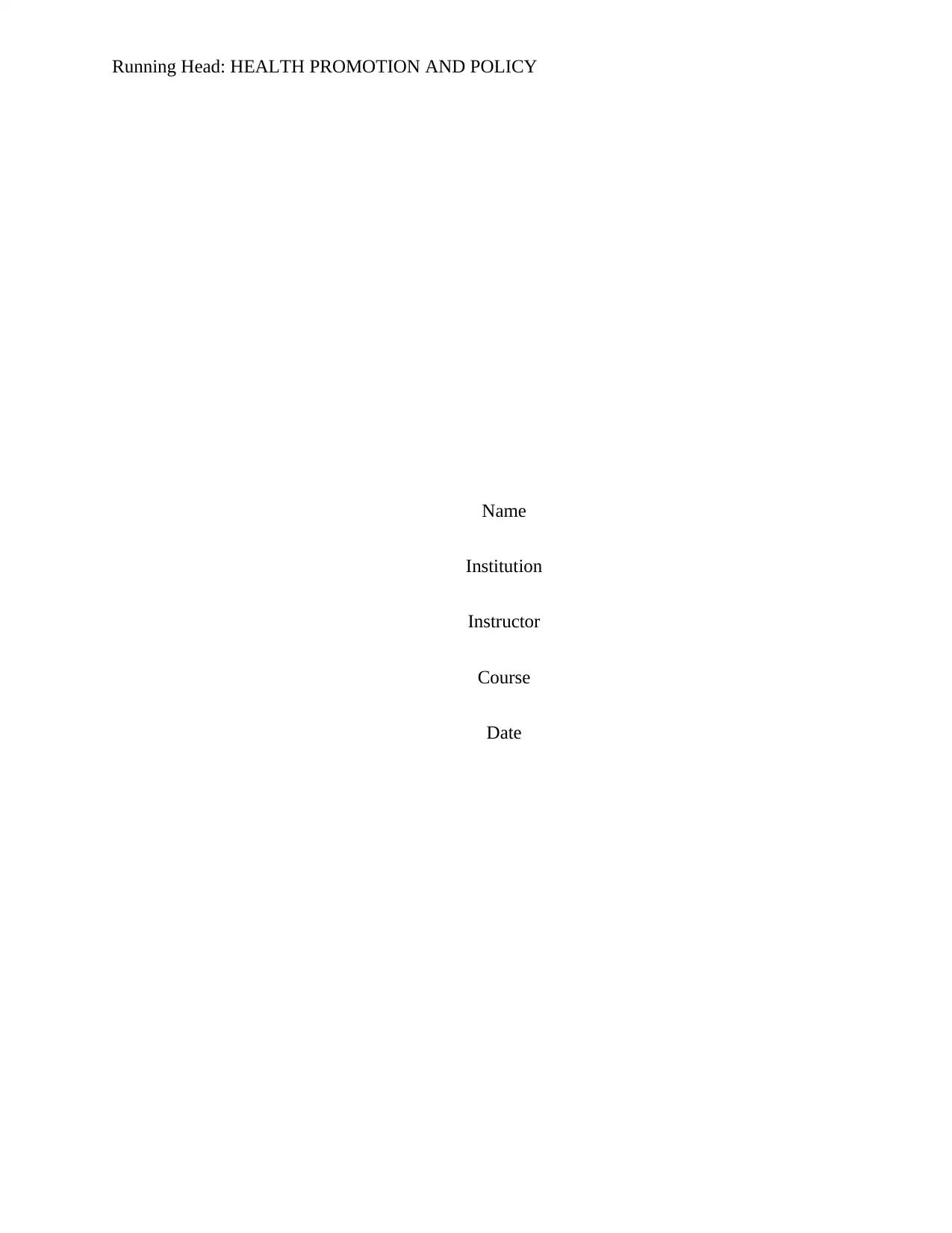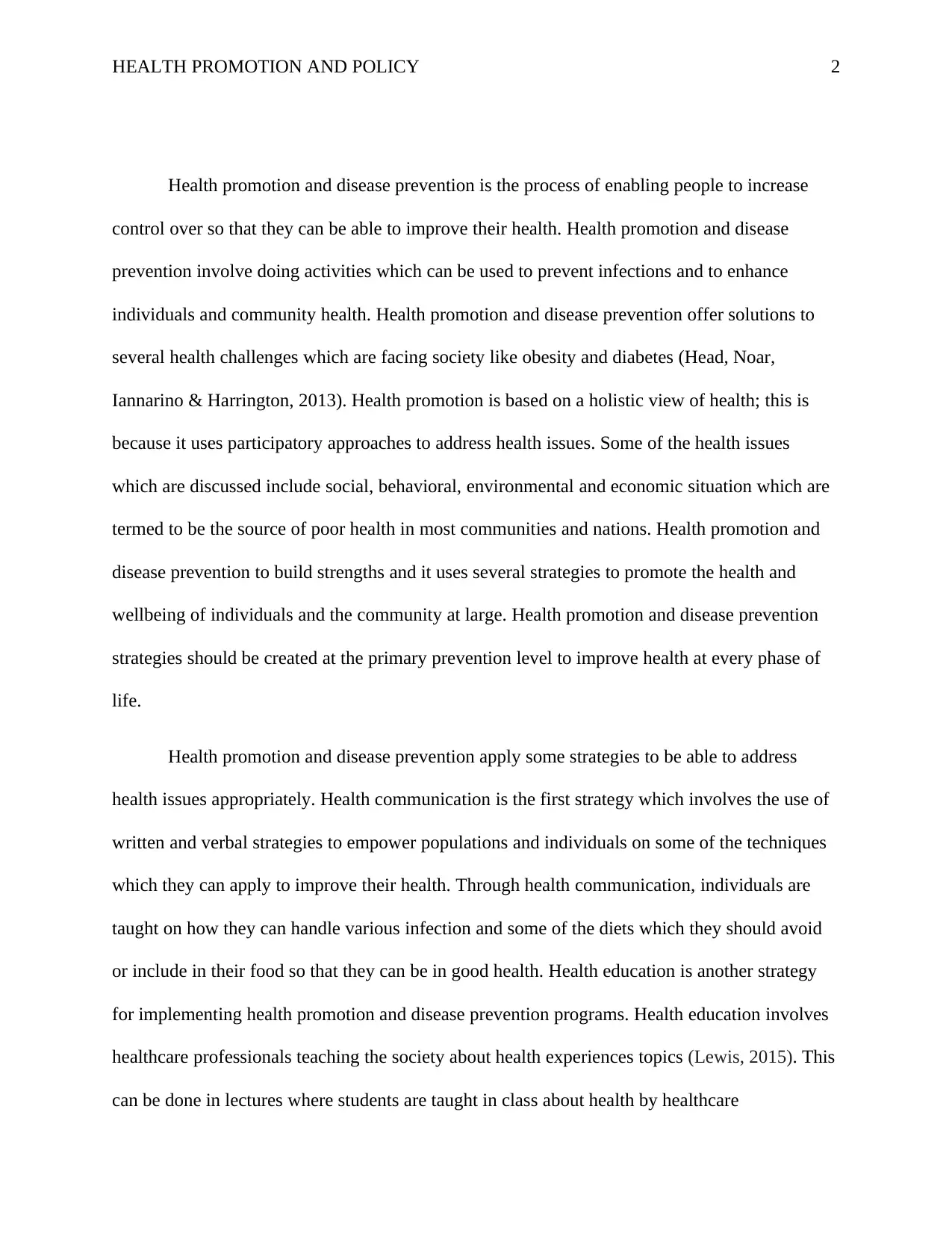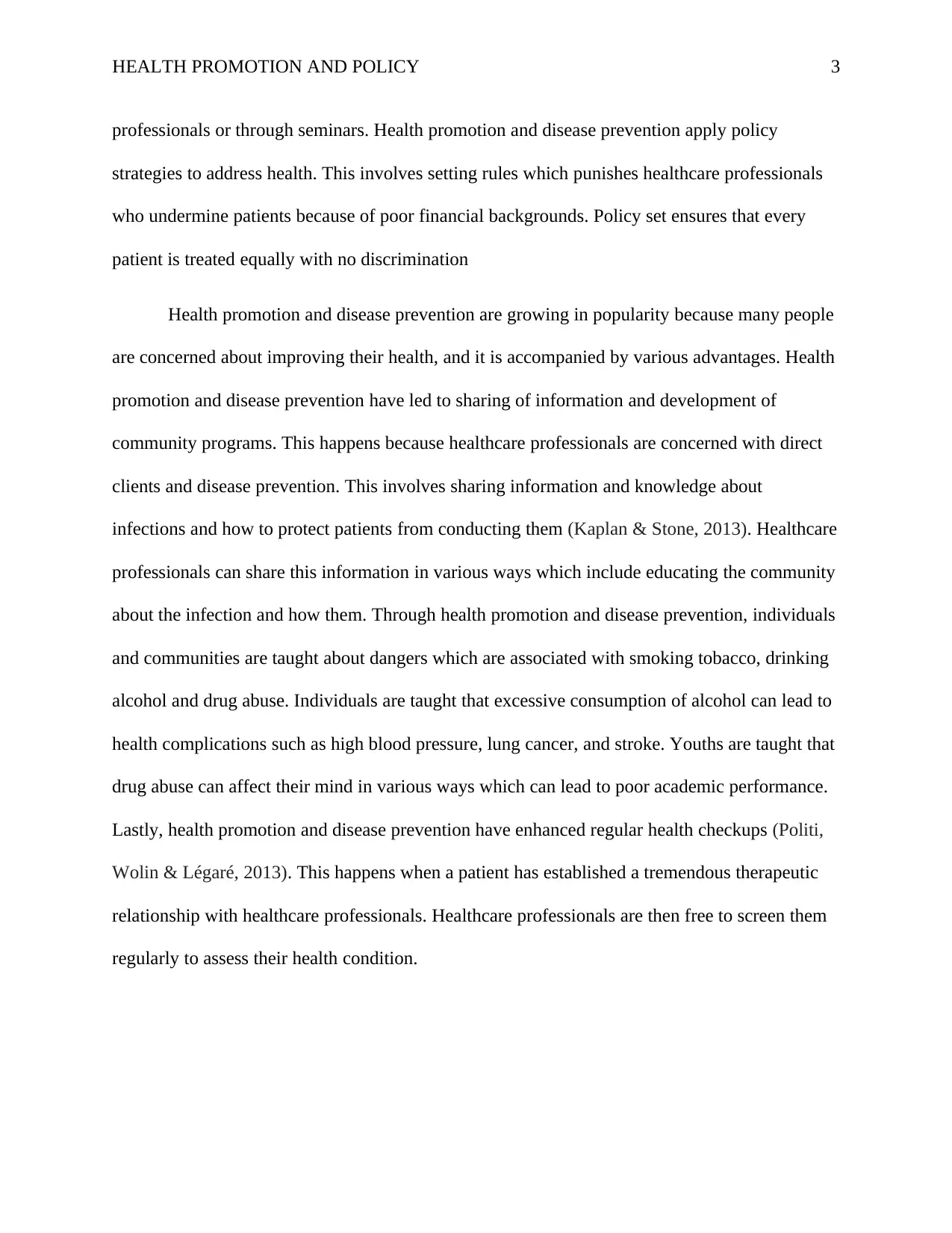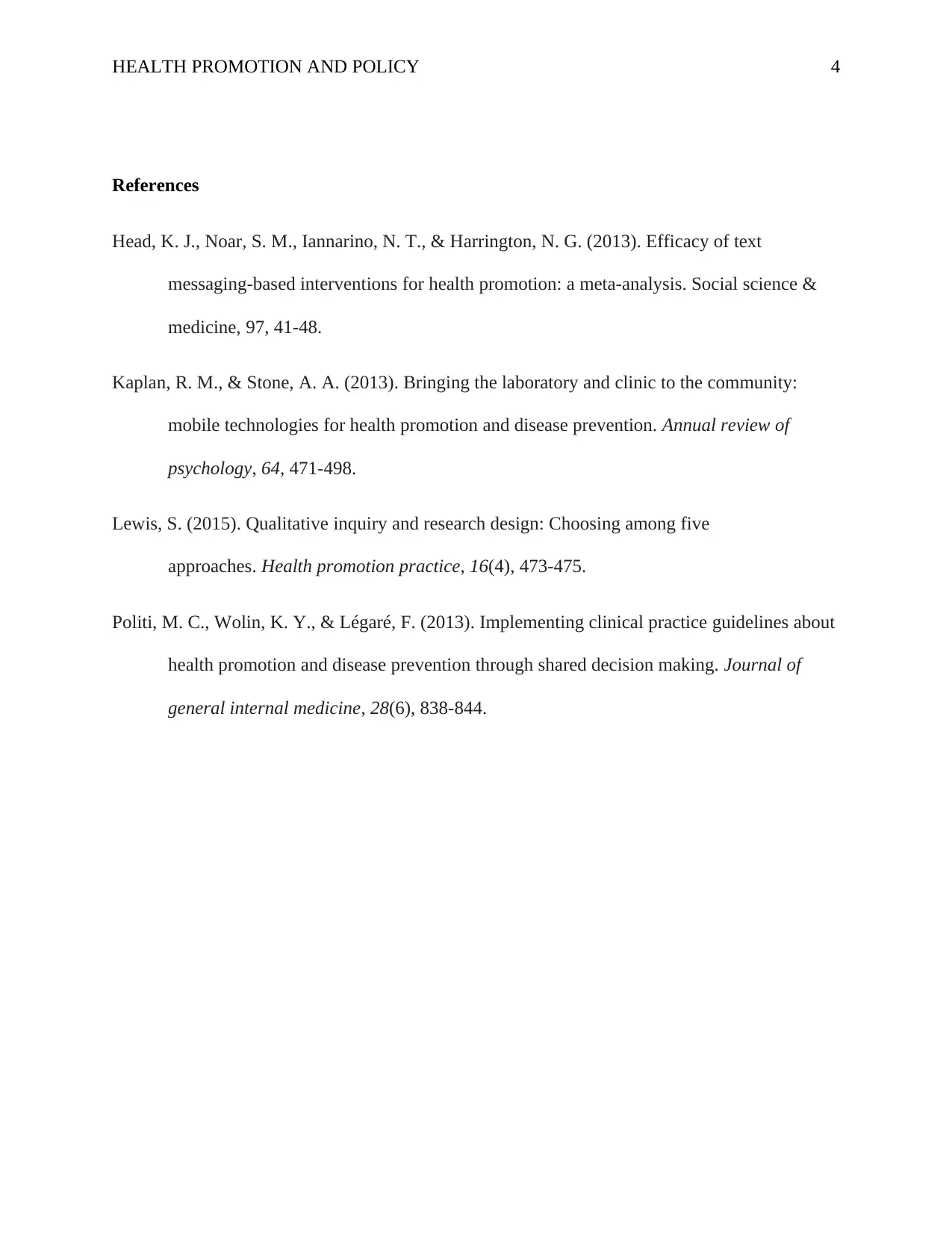Health Promotion and Disease Prevention: Policy and Strategies
VerifiedAdded on 2023/05/31
|4
|787
|113
Essay
AI Summary
This essay discusses health promotion and disease prevention as processes that empower individuals to improve their health, addressing challenges like obesity and diabetes through holistic, participatory approaches. It highlights key strategies such as health communication and education, emphasizing the importance of sharing information and developing community programs to combat issues like tobacco use, alcohol consumption, and drug abuse. The essay also underscores the role of policy in ensuring equitable healthcare access and the benefits of regular health checkups in maintaining overall well-being. This resource is available on Desklib, a platform offering a variety of study tools and solved assignments for students.

Running Head: HEALTH PROMOTION AND POLICY
Name
Institution
Instructor
Course
Date
Name
Institution
Instructor
Course
Date
Paraphrase This Document
Need a fresh take? Get an instant paraphrase of this document with our AI Paraphraser

HEALTH PROMOTION AND POLICY 2
Health promotion and disease prevention is the process of enabling people to increase
control over so that they can be able to improve their health. Health promotion and disease
prevention involve doing activities which can be used to prevent infections and to enhance
individuals and community health. Health promotion and disease prevention offer solutions to
several health challenges which are facing society like obesity and diabetes (Head, Noar,
Iannarino & Harrington, 2013). Health promotion is based on a holistic view of health; this is
because it uses participatory approaches to address health issues. Some of the health issues
which are discussed include social, behavioral, environmental and economic situation which are
termed to be the source of poor health in most communities and nations. Health promotion and
disease prevention to build strengths and it uses several strategies to promote the health and
wellbeing of individuals and the community at large. Health promotion and disease prevention
strategies should be created at the primary prevention level to improve health at every phase of
life.
Health promotion and disease prevention apply some strategies to be able to address
health issues appropriately. Health communication is the first strategy which involves the use of
written and verbal strategies to empower populations and individuals on some of the techniques
which they can apply to improve their health. Through health communication, individuals are
taught on how they can handle various infection and some of the diets which they should avoid
or include in their food so that they can be in good health. Health education is another strategy
for implementing health promotion and disease prevention programs. Health education involves
healthcare professionals teaching the society about health experiences topics (Lewis, 2015). This
can be done in lectures where students are taught in class about health by healthcare
Health promotion and disease prevention is the process of enabling people to increase
control over so that they can be able to improve their health. Health promotion and disease
prevention involve doing activities which can be used to prevent infections and to enhance
individuals and community health. Health promotion and disease prevention offer solutions to
several health challenges which are facing society like obesity and diabetes (Head, Noar,
Iannarino & Harrington, 2013). Health promotion is based on a holistic view of health; this is
because it uses participatory approaches to address health issues. Some of the health issues
which are discussed include social, behavioral, environmental and economic situation which are
termed to be the source of poor health in most communities and nations. Health promotion and
disease prevention to build strengths and it uses several strategies to promote the health and
wellbeing of individuals and the community at large. Health promotion and disease prevention
strategies should be created at the primary prevention level to improve health at every phase of
life.
Health promotion and disease prevention apply some strategies to be able to address
health issues appropriately. Health communication is the first strategy which involves the use of
written and verbal strategies to empower populations and individuals on some of the techniques
which they can apply to improve their health. Through health communication, individuals are
taught on how they can handle various infection and some of the diets which they should avoid
or include in their food so that they can be in good health. Health education is another strategy
for implementing health promotion and disease prevention programs. Health education involves
healthcare professionals teaching the society about health experiences topics (Lewis, 2015). This
can be done in lectures where students are taught in class about health by healthcare

HEALTH PROMOTION AND POLICY 3
professionals or through seminars. Health promotion and disease prevention apply policy
strategies to address health. This involves setting rules which punishes healthcare professionals
who undermine patients because of poor financial backgrounds. Policy set ensures that every
patient is treated equally with no discrimination
Health promotion and disease prevention are growing in popularity because many people
are concerned about improving their health, and it is accompanied by various advantages. Health
promotion and disease prevention have led to sharing of information and development of
community programs. This happens because healthcare professionals are concerned with direct
clients and disease prevention. This involves sharing information and knowledge about
infections and how to protect patients from conducting them (Kaplan & Stone, 2013). Healthcare
professionals can share this information in various ways which include educating the community
about the infection and how them. Through health promotion and disease prevention, individuals
and communities are taught about dangers which are associated with smoking tobacco, drinking
alcohol and drug abuse. Individuals are taught that excessive consumption of alcohol can lead to
health complications such as high blood pressure, lung cancer, and stroke. Youths are taught that
drug abuse can affect their mind in various ways which can lead to poor academic performance.
Lastly, health promotion and disease prevention have enhanced regular health checkups (Politi,
Wolin & Légaré, 2013). This happens when a patient has established a tremendous therapeutic
relationship with healthcare professionals. Healthcare professionals are then free to screen them
regularly to assess their health condition.
professionals or through seminars. Health promotion and disease prevention apply policy
strategies to address health. This involves setting rules which punishes healthcare professionals
who undermine patients because of poor financial backgrounds. Policy set ensures that every
patient is treated equally with no discrimination
Health promotion and disease prevention are growing in popularity because many people
are concerned about improving their health, and it is accompanied by various advantages. Health
promotion and disease prevention have led to sharing of information and development of
community programs. This happens because healthcare professionals are concerned with direct
clients and disease prevention. This involves sharing information and knowledge about
infections and how to protect patients from conducting them (Kaplan & Stone, 2013). Healthcare
professionals can share this information in various ways which include educating the community
about the infection and how them. Through health promotion and disease prevention, individuals
and communities are taught about dangers which are associated with smoking tobacco, drinking
alcohol and drug abuse. Individuals are taught that excessive consumption of alcohol can lead to
health complications such as high blood pressure, lung cancer, and stroke. Youths are taught that
drug abuse can affect their mind in various ways which can lead to poor academic performance.
Lastly, health promotion and disease prevention have enhanced regular health checkups (Politi,
Wolin & Légaré, 2013). This happens when a patient has established a tremendous therapeutic
relationship with healthcare professionals. Healthcare professionals are then free to screen them
regularly to assess their health condition.
⊘ This is a preview!⊘
Do you want full access?
Subscribe today to unlock all pages.

Trusted by 1+ million students worldwide

HEALTH PROMOTION AND POLICY 4
References
Head, K. J., Noar, S. M., Iannarino, N. T., & Harrington, N. G. (2013). Efficacy of text
messaging-based interventions for health promotion: a meta-analysis. Social science &
medicine, 97, 41-48.
Kaplan, R. M., & Stone, A. A. (2013). Bringing the laboratory and clinic to the community:
mobile technologies for health promotion and disease prevention. Annual review of
psychology, 64, 471-498.
Lewis, S. (2015). Qualitative inquiry and research design: Choosing among five
approaches. Health promotion practice, 16(4), 473-475.
Politi, M. C., Wolin, K. Y., & Légaré, F. (2013). Implementing clinical practice guidelines about
health promotion and disease prevention through shared decision making. Journal of
general internal medicine, 28(6), 838-844.
References
Head, K. J., Noar, S. M., Iannarino, N. T., & Harrington, N. G. (2013). Efficacy of text
messaging-based interventions for health promotion: a meta-analysis. Social science &
medicine, 97, 41-48.
Kaplan, R. M., & Stone, A. A. (2013). Bringing the laboratory and clinic to the community:
mobile technologies for health promotion and disease prevention. Annual review of
psychology, 64, 471-498.
Lewis, S. (2015). Qualitative inquiry and research design: Choosing among five
approaches. Health promotion practice, 16(4), 473-475.
Politi, M. C., Wolin, K. Y., & Légaré, F. (2013). Implementing clinical practice guidelines about
health promotion and disease prevention through shared decision making. Journal of
general internal medicine, 28(6), 838-844.
1 out of 4
Related Documents
Your All-in-One AI-Powered Toolkit for Academic Success.
+13062052269
info@desklib.com
Available 24*7 on WhatsApp / Email
![[object Object]](/_next/static/media/star-bottom.7253800d.svg)
Unlock your academic potential
Copyright © 2020–2025 A2Z Services. All Rights Reserved. Developed and managed by ZUCOL.





